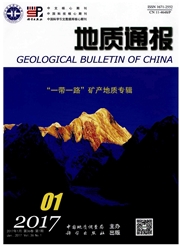

 中文摘要:
中文摘要:
对大兴安岭中段扎兰屯市西南柴河地区玛尼吐组火山岩进行LA—ICP—MS锆石U—Pb定年和岩石地球化学分析。LA—ICP—MS锆石U—Pb定年结果显示其形成年龄为135Ma。火山岩SiO2含量为59.5%-70.8%,富碱高钾,σ值介于3.2~4.7之间,属钾玄岩系列。稀土元素总量较低(∑REE=112×10^-66-172×10^-6),轻重稀土元素分馏较明显(La/Yb)N=6.5-9.2,具中等负Eu异常(BEu=0.54-0.77)。富集大离子亲石元素Ba、K和轻稀土元素,亏损高场强元素№、Ti、P,铁族元素Cr、Co、Ni含量普遍偏低,表明研究区玛尼吐组火山岩形成于蒙古-鄂霍茨克闭合造山后的岩石圈伸展构造环境。与大兴安岭北段玛尼吐组火山岩具有相似的形成环境。而大兴安岭玛尼吐组火山岩产生于挤压、隆升的构造背景下。
 英文摘要:
英文摘要:
In this study, LA-ICP-MS zircon U-Pb dating results and geochemical data were obtained from the volcanic rocks in Manitu Formation of Chaihe area lying in southwest Zhalantun City of central Da Hinggan Mountains. Zircon U-Pb dating results show that they were formed in early Cretaceous(135Ma). The volcanic rocks belonging chemically to the shoshonite series have SiO2 59.5%--70.8% and are enriched in alkali and potassium, with Rittman index from 3.2 to 4.7(σ=3.2-4.7). In addition, they are characterized by low total rare earth elements (∑REE=112×10^-6-172×10^-6), significant fractionations of REE(La/Yb)N=6.5-9.2), moderate negative Eu anomalies (BEu=0.54-0.77), enrichment of large ion lithophile elements (LILEs, such as Ba and K) and light rare earth elements (LREEs) and depletion of high field strength elements (HFSEs, such as Nb, Ti and P). The values of such iron family elements as Cr, Co and Ni are all low (Cr=6.55×10^-6, Cr=6.97×10^-6, Ni=4.35×10^-6 on average). Recent researches show that the volcanic rocks might have been formed in an extensional setting after the closure of the Mongol-Okhotsk Ocean. Considering the regional resources, the authors have reached the conclusion that the volcanic rocks in Manim Formation of central Da Hinggan Mountains region were formed in two structural environments. Total REE amounts are relatively low( ∑REE = 112 × 10^-6-172× 10^-6, fractionation between LREE and HREE (La/Yb)N=6.5-9.2) is obvious, and there exist moderate negative Eu anomalies (δEu=0.54-0.77). They are enriched in high LILE (e.g., Ba, K) and LREE, and depleted in HFSE (e.g., Nb, Ti, P) and iron family elements such as Cr, Co and Ni(Cr=6.55×10^-6, Cr=6.97×10^-6, Ni=4.35×10^-6 on average). The research above shows that the tectonic background of Manitu Formation volcanics in the study area are formed on the lithospheric extensional structure after the closure orogeny of Mongolia-Ehucike, which is similar to the north section of the
 同期刊论文项目
同期刊论文项目
 同项目期刊论文
同项目期刊论文
 期刊信息
期刊信息
